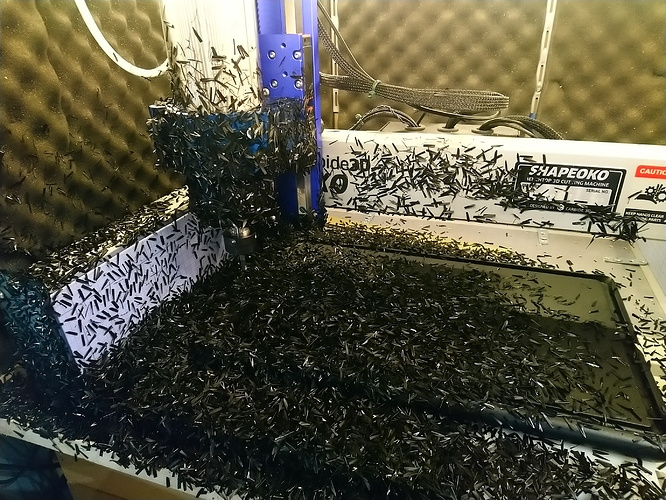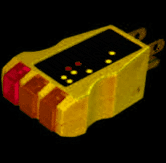Possibly: cut HDPE with no dust collection…cannot get a worse scenario than this

(and my machine did NOT disconnect during that cut…I’m lucky like that)
Possibly: cut HDPE with no dust collection…cannot get a worse scenario than this

(and my machine did NOT disconnect during that cut…I’m lucky like that)
I love this picture. Reminds me of several black-goo creatures from sci-fi films.
EDIT: I also fancy a plate of spaghetti al nero di seppia now.
I have a regular old 30’ shop vac hose attached to an Oneida Cobra Vacuum. When I first hooked it up, the hose ended up covered in fine dust, stuck on by static. I KNOW it’s not supposed to work, but I took a long piece of copper ground wire, wrapped it around the OUTSIDE of the hose (photo below), and tied it off to a gas supply line that I knew was grounded. Everyone will tell you that this won’t work…but I don’t have any more static build up on that hose. I was prepared to run the wire through the hose, and was wondering the same thing about how to get it out of the hose without damaging the hose and losing suction…but I never had to deal with it. Maybe give that a try first? It worked for me and was really easy to do.
Ah, so the Shapeoko isn’t grounded either then.
You could certainly try just grounding the hose to a radiator yes, they are generally grounded reasonably well, although a safety inspector or a plumber might shout at you. Not much current, we’re just leaking away the static charge.
I’d just ground the hose first as it’s normally the major offender.
You could just put a humidifier in the room with it?
The humidity in Copenhagen right now is 95%… any more humid and the walls will drip 
Well it’s probably not a low humidity issue then 
What’s actually going on, based on my knowledge of how humidity affects computer servers and data centers, is that when either the local relative humidity or ambient temperature is very low these conditions allow significant static charge to build up where you have moving air or dust particles.
Above is the psychrometrics page on Wikipedia.
The factor that seems to control the conductivity of the air and therefore it’s ability to leak away static charge is the absolute humidity, this is the ratio by mass of water vapor to the rest of the air.
The humidity ratio is not the ‘humidity’ they talk about on the weather forecast. The amount of water the air can hold before saturation depends on the temperature. The warmer the air the more water it can hold. At saturation rain, cloud or fog forms. Relative humidity is a measure where you are between desert dry and san-francisco summer for that air temperature.
The important bit is that the actual amount of water in the air (humidity ratio) does not change as cold outdoor air comes inside and gets warmed up. The amount of water the air can carry does increase though, so the relative humidity reduces. This is why it’s dry indoors during a cold winter, even if it’s raining outside.
Conversely, if you take air with some water vapour in it and cool it down the saturation limit reduces, the relative humidity goes up and some form of condensation forms. This is why clouds and rain work (it’s cold at altitude), why aeroplanes and other things with wings form vapour trails, why you can’t boil a kettle properly on top of a mountain etc.
So when you’re machining with your Shapeoko on a cold winter day (or on any day in Arizona) there is so little water in the air that there’s not enough conductivity in the air to bleed away the static charge so instead it builds up and zaps either you or your Shapeoko.
HTH
And which points out that you want to override that organic process with one that is purely mechanical and reliable … copper wire. Provide a low resistance path so the static electrical field won’t build up in the first place, and will be continuously discharged.
Back when I designed instruments for HP, we had a static discharge tester that was basically a capacitor tied to a metal screw on the end of a non-conducting handle. Don’t know if these are easily available; I think we made ours. You could vary the voltage, capacitance and ESR to test to different models (human body M/F, assembly machine, packaging machine, etc.). The voltage involved in these devices is not to be trifled with; occasionally the thing would discharge back through the handle and this usually resulted in it being thrown about the room.
Partially yes.
I was more looking at why some people have an issue and others don’t, or only occasionally have an issue.
With regard to discharging the static, you can only discharge it from areas that you have conductivity to. There will still be static on the workpiece and chips and on any other parts which come into contact with these, unless they are conductive and have a path to ground. So you’re still likely to see chips clogging in the cut in plastics as there’s no discharge path once the cutter has moved on down the cut.
the thing would discharge back through the handle and this usually resulted in it being thrown about the room.
along with a few obscenities I would imagine
I have seen static jump 12 to 14 inches. When it gets you, it hurts…
I will toss this out there and experienced folks can maybe build on it. Along with this disclaimer, I am not a scientist, guru, or high educated person. It is difficult for me to transfer my scrambled thoughts to words that create coherent sentences.
Static takes a non-conductive material to build up in, and a conductive material that gives the charge. That could be the vac hose (accumulating), but it could also be the machine itself since it sits on non conductive wheels, but the machine frame is conductive in sections. Grounding the entire mess should create a path for the charge to dissipate. A bigger step would be to use wiring that has a shielding and a drain system built into it to accept the static before it can get into the electronics (that’s what I did, re-wired)
The above makes me wonder if the actual charge is not built up at the contact from the Bit (conductive) to the Material being milled (non-conductive) the static charged chips move up into the vac hose and a charge accumulates. …( has anyone here had a static problem when milling metal? no?)
Do not take any of the above as scientific or even accurate, just a way that I have tried to give a different train of thought for a common issue.
…some of the best move in a game of chess are seen by a uninvolved watcher from the side.
now that I re-read this I probably should not have written it, but to much time wasted if I delete it.
Blockquote
The USB signals from the computer are injected into a set of primary coils, where they couple “wirelessly” (via the magnetic field) to a secondary set of coils, where they are then translated back into (wired) USB signals to the controller. What you get in the process is that there is no electrical connection between the two sides anymore, so the nasty EMI gremlins stay on the side they are at.
I am no expert, but I think EMI would cross this isolator unless it also contains a filter. (EMI =electromagnetic interference - usually high frequency noise, could be picked up from a nearby motor, power line, or other conductor acting as an antenna). This is what gets partially filtered out by ferrites (or “chokes”) - those cylindrical lumps on some USB cables.
Isolations transformers like this are used to isolate DC voltages (i.e. not high frequency noise) - so if one side is not properly grounded, and/or there is a harmful voltage (e.g more than 5V) on the USB cable for some reason, it won’t fry the computer.
The point being, this isolator could prevent static from dissipating through your laptop, but would not prevent EMI from causing trouble if that is what is causing disconnections. There are optical USB isolators that would do a better job of cutting EMI. Apologies if I’m saying something you all knew already! Just throwing it out there in case it helps someone chasing down electrical gremlins causing disconnection issues.
There’s more than just a filter in there, it decodes the USB signal and re-transmits.
https://www.analog.com/en/products/interface-isolation/isolation/usb-isolators.html#
Good for isolating common mode noise and breaking ground loops. However, the Shapeoko controller board already has an isolating USB chipset so…
Per Wireless - Has anyone used Bart Dring’s: GRBL_ESP32 controller on a Shapeoko?
I am planning on building another CNC using that approach.
As for EMF/RFI ground issue, I just took an old extension cord and cut off the neutral and hot wires (at the plug) so just the ground remained and plugged my frame into the power source.
Jim,
That approach would work for us here in the US. I had asked earlier which type of plug he had and it was a type C plug. A European type C plug only has two prongs, neutral and hot at 230VAC. So there is no ground plug he can plug into.
In the US the NEC (National Electric Code) requires a separate ground for 120VAC plugs. The Europeans do have 3 pronged plugs with ground but from my research it is not required everywhere in Europe. So with a 2 prong Type C plug there is no ground available. However you might want to run a grounding cable to a radiator, gas pipe or water pipe. Again plastic (pex) pipe is very common and this clamping to ground will only work if the pipes are copper or steel. I would suspect a steam radiator would be your best bet because they usually have metal pipes where faucets may be made of metal but they are connected by plastic pipes.
Older US homes with only 2 prong outlets have the same problem. Those older systems are being replaced over time and will eventually be phased out. Some times in an older home without a dedicated ground will have a receptacle replaced from a 2 prong to a 3 prong. This does not create a true ground. You can buy little testers at the hardware store that check your plugs for polarity and grounding.

Just a quick update. I found some old cobber wire, stuck about 1 m of it inside the hose, wrapped it around 1 m length of the hose and then attached the other end to my radiator.
I ran a 1 hour cutting program yesterday and there was no disconnect, so I think that might have done the trick.
This topic was automatically closed 30 days after the last reply. New replies are no longer allowed.